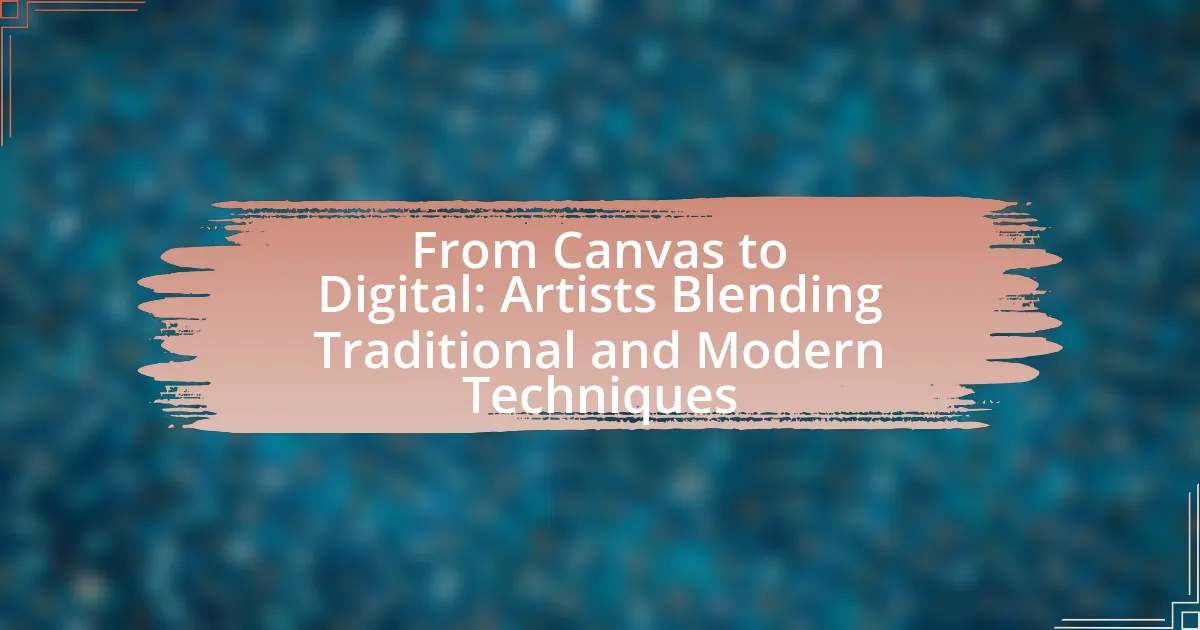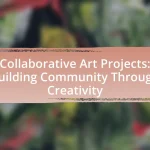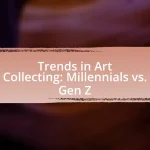The article “From Canvas to Digital: Artists Blending Traditional and Modern Techniques” explores the integration of established artistic methods with contemporary practices, highlighting how artists combine traditional techniques like painting and sculpture with digital media. It examines the historical transition from canvas to digital mediums, the common traditional techniques used today, and how modern digital tools enhance these methods. The significance of this blending in contemporary art is discussed, along with the cultural shifts that have influenced it, the challenges artists face, and the resources available for learning digital methods. Additionally, the article showcases successful examples of artists who exemplify this fusion and identifies emerging trends and new mediums in the art world.
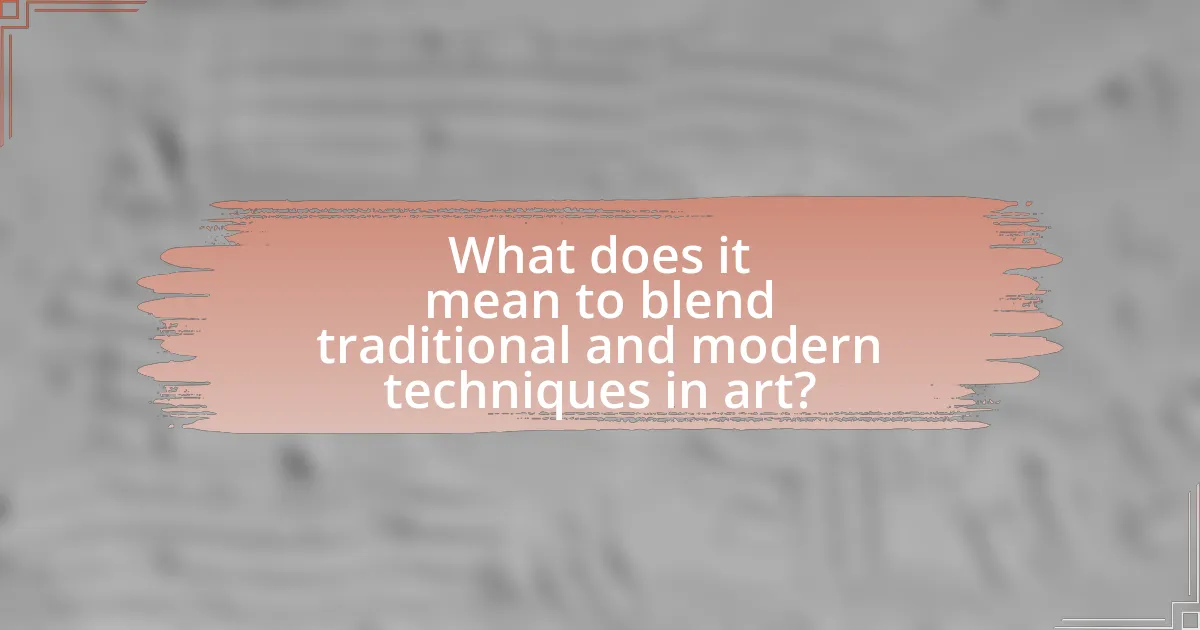
What does it mean to blend traditional and modern techniques in art?
Blending traditional and modern techniques in art means integrating established artistic methods, such as painting or sculpture, with contemporary practices, including digital media and mixed media. This fusion allows artists to create innovative works that reflect both historical influences and current technological advancements. For example, artists may use traditional brushwork alongside digital tools to enhance their compositions, thereby expanding the possibilities of expression and creativity. This approach not only preserves the heritage of art but also embraces the evolution of artistic practices in the digital age.
How have artists historically transitioned from canvas to digital mediums?
Artists have historically transitioned from canvas to digital mediums through the adoption of technology that allows for new forms of expression and creativity. The introduction of digital tools, such as graphic tablets and software like Adobe Photoshop in the late 20th century, enabled artists to replicate traditional techniques while exploring innovative styles. For instance, the rise of the internet in the 1990s facilitated the sharing of digital art, leading to a broader acceptance and integration of digital practices in the art community. This shift is evidenced by the increasing number of exhibitions dedicated to digital art and the emergence of digital art movements, which reflect a blend of traditional and modern techniques.
What traditional techniques are commonly used by artists today?
Artists today commonly use traditional techniques such as oil painting, watercolor, acrylic painting, charcoal drawing, and printmaking. These methods have persisted due to their rich history and the tactile quality they bring to artwork. For instance, oil painting, which dates back to the 15th century, allows for a depth of color and texture that many contemporary artists still favor. Watercolor, known for its fluidity and transparency, remains popular for its ability to create delicate washes and intricate details. Charcoal drawing, with its versatility, is often employed for sketching and detailed studies. Printmaking techniques, including etching and lithography, are also utilized, allowing artists to produce multiple copies of their work while maintaining high quality. These traditional techniques continue to be integrated with modern practices, demonstrating their enduring relevance in the art world.
How do modern digital tools enhance traditional artistic methods?
Modern digital tools enhance traditional artistic methods by providing artists with advanced techniques for creation, manipulation, and distribution of their work. These tools, such as graphic design software and digital painting applications, allow for greater precision and flexibility, enabling artists to experiment with colors, textures, and forms that may be difficult to achieve with traditional media. For instance, programs like Adobe Photoshop and Procreate offer layers and undo options, which facilitate iterative processes and corrections without damaging the original artwork. Additionally, digital platforms enable artists to reach wider audiences through online galleries and social media, expanding the visibility of their traditional techniques in a contemporary context.
Why is the blending of techniques significant in contemporary art?
The blending of techniques is significant in contemporary art because it fosters innovation and expands creative possibilities. By integrating traditional methods with modern technologies, artists can create hybrid forms that challenge conventional boundaries and engage diverse audiences. For instance, the use of digital tools alongside painting or sculpture allows for new expressions and interactive experiences, as seen in the works of artists like Rafael Lozano-Hemmer, who combines installation art with digital media. This fusion not only reflects the complexities of contemporary life but also encourages dialogue about the nature of art itself, making it more relevant in today’s society.
What cultural shifts have influenced this blending of techniques?
The blending of traditional and modern artistic techniques has been influenced by the cultural shift towards digital technology and globalization. The rise of the internet and social media has democratized art, allowing artists to share their work globally and access diverse influences. This exposure to various cultures and styles has encouraged artists to experiment with combining traditional methods, such as painting and drawing, with digital tools like graphic design software and digital painting applications. Additionally, the increasing acceptance of hybrid art forms in contemporary art movements has further facilitated this blending, as seen in exhibitions that showcase works integrating both traditional and digital elements.
How does this blending impact the perception of art in society?
The blending of traditional and modern techniques significantly alters the perception of art in society by expanding the definition of what art can be. This fusion allows for greater accessibility and engagement, as digital platforms enable artists to reach wider audiences and interact with them in real-time. For instance, the rise of digital art forms, such as NFTs, has challenged conventional notions of ownership and value in art, prompting discussions about authenticity and creativity. According to a report by Art Basel and UBS, the global art market reached $65.1 billion in 2018, with a notable increase in online sales, indicating a shift in how art is consumed and appreciated. This evolution reflects a society increasingly open to diverse artistic expressions, ultimately reshaping cultural narratives around art.
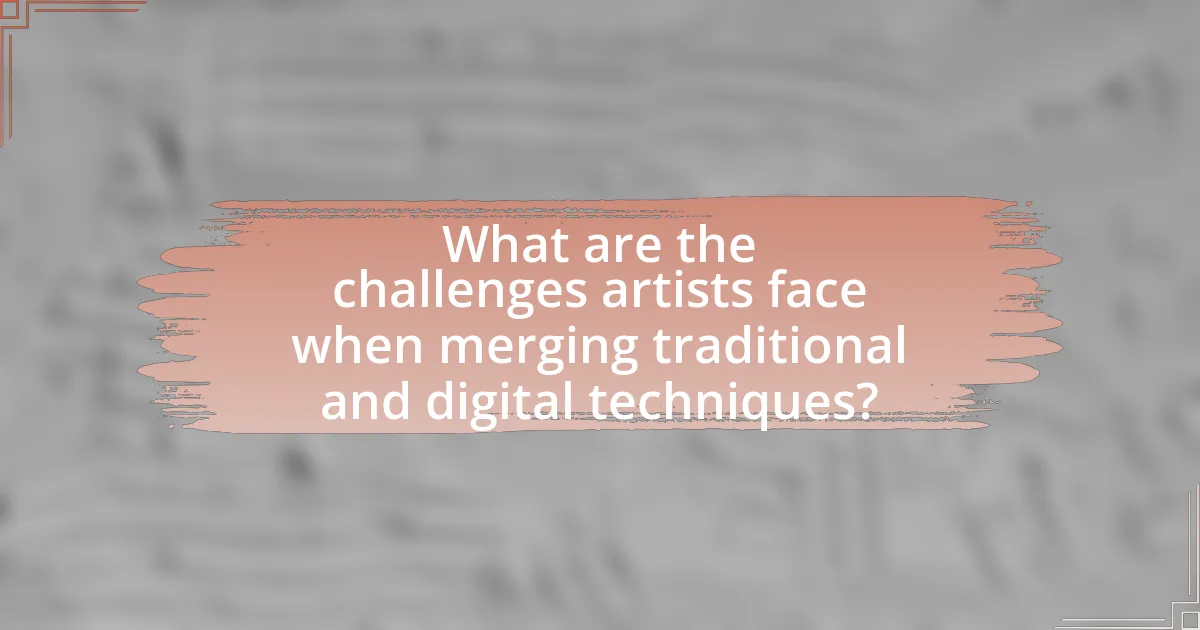
What are the challenges artists face when merging traditional and digital techniques?
Artists face several challenges when merging traditional and digital techniques, primarily including the learning curve associated with new technologies, the preservation of artistic intent, and the integration of different mediums. The learning curve can be steep, as artists must familiarize themselves with software and digital tools that differ significantly from traditional methods. This transition can lead to frustration and a sense of loss regarding their established skills. Additionally, artists often struggle to maintain their original artistic vision when adapting their work to digital formats, as the characteristics of digital media can alter the perception of their art. Finally, the integration of traditional and digital techniques can result in inconsistencies in style and execution, making it difficult for artists to achieve a cohesive final product. These challenges highlight the complexities involved in blending two distinct artistic approaches.
How do artists overcome technical limitations in digital art?
Artists overcome technical limitations in digital art by utilizing advanced software tools and techniques that enhance their creative capabilities. For instance, many artists leverage programs like Adobe Photoshop and Procreate, which offer features such as layering, brushes, and filters that mimic traditional media while providing flexibility and precision. Additionally, artists often engage in continuous learning through online tutorials and workshops, allowing them to master new tools and techniques that expand their skill set. This adaptability is crucial, as it enables artists to push the boundaries of their creativity and produce high-quality work despite the inherent limitations of digital platforms.
What skills are necessary for artists to effectively blend these techniques?
Artists need a combination of technical proficiency, creativity, and adaptability to effectively blend traditional and modern techniques. Technical proficiency includes mastery of traditional mediums such as painting and drawing, as well as digital tools like graphic design software. Creativity allows artists to innovate and experiment with different styles and methods, while adaptability enables them to transition smoothly between various techniques and platforms. For instance, artists who are skilled in both oil painting and digital illustration can create hybrid works that leverage the strengths of each medium, enhancing their artistic expression.
How can artists maintain their unique style while adapting to digital tools?
Artists can maintain their unique style while adapting to digital tools by integrating their traditional techniques with digital methods. This approach allows artists to preserve their distinctive aesthetic while leveraging the advantages of digital platforms. For instance, artists can use digital brushes that mimic traditional media, enabling them to create familiar textures and effects. Additionally, they can experiment with layering and editing capabilities that digital tools offer, enhancing their creative process without losing their original style. Research indicates that artists who blend traditional and digital techniques often report increased satisfaction and innovation in their work, demonstrating that adaptation does not necessitate the abandonment of personal style.
What role does education play in the transition from canvas to digital?
Education plays a crucial role in the transition from canvas to digital by equipping artists with the necessary skills and knowledge to navigate digital tools and platforms. Through formal education programs, artists learn about software applications, digital techniques, and the principles of design that are essential for creating digital art. For instance, institutions like the Rhode Island School of Design offer courses specifically focused on digital media, which prepare students to effectively blend traditional artistic methods with modern technology. This educational foundation not only enhances their technical abilities but also fosters creativity and innovation, enabling artists to explore new forms of expression in the digital realm.
How are art schools adapting their curricula to include digital techniques?
Art schools are adapting their curricula to include digital techniques by integrating courses focused on digital art, design software, and multimedia production. This shift reflects the growing demand for skills in digital media, as evidenced by the increasing number of job opportunities in fields such as graphic design and animation, which require proficiency in digital tools. Many institutions now offer specialized programs that combine traditional art practices with digital technologies, ensuring students are equipped with a comprehensive skill set that meets industry standards. Additionally, art schools are collaborating with technology companies to provide students access to the latest software and hardware, further enhancing their learning experience and preparing them for the evolving art landscape.
What resources are available for artists looking to learn digital methods?
Artists looking to learn digital methods can access a variety of resources, including online courses, tutorials, and software training. Platforms like Skillshare and Udemy offer structured courses on digital art techniques, while YouTube hosts numerous free tutorials from experienced digital artists. Additionally, software companies such as Adobe provide official training resources for programs like Photoshop and Illustrator, which are widely used in digital art. These resources are validated by the growing number of artists transitioning to digital mediums, as evidenced by industry reports indicating a significant increase in digital art sales and interest over the past decade.
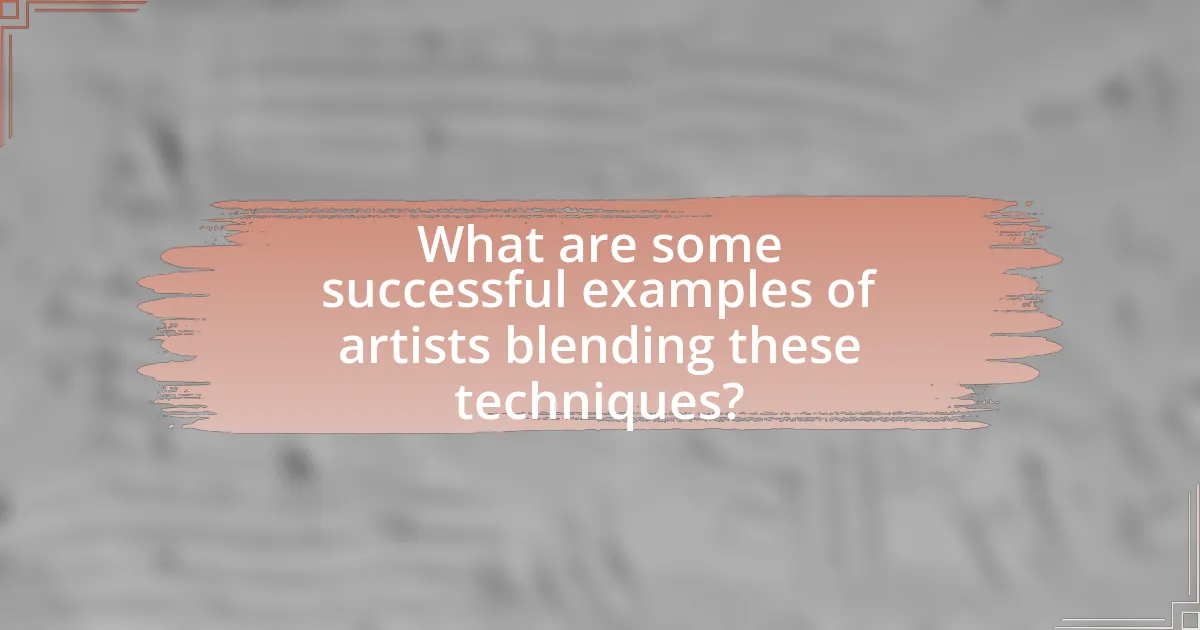
What are some successful examples of artists blending these techniques?
Successful examples of artists blending traditional and modern techniques include Takashi Murakami, who combines traditional Japanese painting styles with contemporary pop culture elements, and Kehinde Wiley, who merges classical portraiture with modern subjects and vibrant backgrounds. Murakami’s work often features techniques like Nihonga, while Wiley employs oil painting methods alongside digital processes to create his compositions. These artists exemplify the successful integration of historical art forms with modern technology, showcasing how traditional techniques can enhance contemporary artistic expression.
How do specific artists exemplify the fusion of traditional and digital art?
Specific artists exemplify the fusion of traditional and digital art by integrating techniques and mediums from both realms to create innovative works. For instance, artist Takashi Murakami combines traditional Japanese painting styles with digital technology, producing vibrant pieces that reflect both cultural heritage and contemporary aesthetics. Similarly, the work of Julie Mehretu showcases hand-drawn elements layered with digital prints, merging physical and virtual spaces to explore themes of geography and history. These artists demonstrate how traditional methods can enhance digital practices, resulting in a hybrid art form that resonates with diverse audiences.
What techniques do these artists use to create their unique styles?
Artists blend traditional and modern techniques to create their unique styles by incorporating methods such as layering, mixed media, and digital manipulation. Layering allows artists to build depth and texture, often seen in both painting and digital art, where multiple elements are combined to enhance visual complexity. Mixed media techniques involve the use of various materials, such as combining paint with collage or digital elements, which expands the creative possibilities and results in distinctive artworks. Digital manipulation enables artists to alter and enhance their work through software, allowing for precision and experimentation that traditional methods may not offer. These techniques collectively contribute to the evolution of artistic expression, showcasing the seamless integration of historical practices with contemporary innovations.
How have these artists influenced the broader art community?
These artists have significantly influenced the broader art community by integrating traditional techniques with modern digital practices, thereby expanding the definition of artistic expression. Their work has encouraged a new generation of artists to explore hybrid forms, blending mediums such as painting and digital art, which has led to innovative styles and approaches. For instance, artists like Takashi Murakami and Kehinde Wiley have successfully merged classical painting techniques with contemporary themes, inspiring exhibitions that attract diverse audiences and provoke discussions about cultural identity and the evolution of art. This shift has been documented in various art critiques and exhibitions, highlighting the growing acceptance and recognition of digital art as a legitimate form of artistic expression.
What trends are emerging in the art world regarding this blending of techniques?
Emerging trends in the art world regarding the blending of traditional and modern techniques include the increasing use of digital tools alongside traditional mediums, such as painting and sculpture. Artists are now frequently incorporating digital elements, like augmented reality and 3D printing, into their work, creating hybrid pieces that engage viewers in new ways. For instance, exhibitions often feature interactive installations that combine physical artworks with digital projections, enhancing the viewer’s experience. This trend reflects a broader movement towards interdisciplinary practices, where artists draw from various fields, including technology and design, to innovate and expand the boundaries of art.
How is technology shaping the future of art creation?
Technology is significantly shaping the future of art creation by enabling artists to utilize digital tools and platforms that enhance creativity and accessibility. Digital art software, such as Adobe Creative Suite and Procreate, allows for innovative techniques that blend traditional methods with modern technology, resulting in new forms of expression. Additionally, advancements in artificial intelligence, like generative art algorithms, empower artists to explore uncharted creative territories, producing unique artworks that challenge conventional boundaries. The rise of online galleries and social media platforms facilitates broader audience reach, democratizing art distribution and allowing artists to connect with global communities. This integration of technology not only transforms the artistic process but also redefines the relationship between artists and their audiences.
What new mediums are artists exploring as a result of this blending?
Artists are exploring new mediums such as augmented reality (AR), virtual reality (VR), and digital installations as a result of blending traditional and modern techniques. This shift allows artists to create immersive experiences that engage audiences in innovative ways, combining physical art forms with digital technology. For instance, AR applications enable viewers to interact with artworks through their smartphones, enhancing the visual experience with additional layers of information or animation. Similarly, VR environments allow artists to construct entirely virtual spaces where viewers can navigate and experience art in a three-dimensional context. These mediums reflect a growing trend in contemporary art that merges tactile and digital elements, expanding the boundaries of artistic expression.
What practical tips can artists follow to successfully blend traditional and digital techniques?
Artists can successfully blend traditional and digital techniques by integrating both mediums in a cohesive workflow. To achieve this, artists should start by creating traditional sketches or paintings, then scan or photograph their work to import it into digital software. This allows for the enhancement of colors, textures, and details that may be difficult to achieve with traditional methods alone. Additionally, artists can utilize digital tools to experiment with layering and effects, which can complement their traditional techniques.
For instance, using software like Adobe Photoshop or Procreate enables artists to manipulate their traditional artwork, adding digital elements while preserving the original style. This approach not only enhances creativity but also allows for greater flexibility in the artistic process. Furthermore, artists should consider maintaining a consistent style across both mediums to ensure a harmonious blend, which can be achieved through practice and experimentation.
